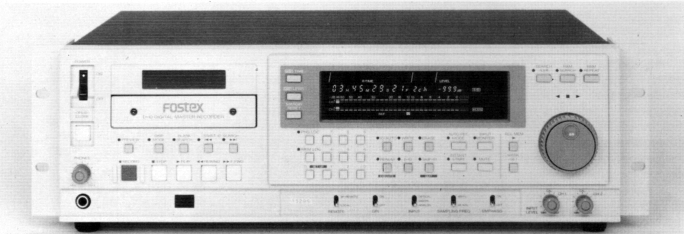
by Jerry Vigil
Is DAT here to stay? Well, if the past five years are any indication, the answer is yes. It may not be the format for the consumer, the cassette's replacement, but stations and studios continue to invest in DAT decks, and major manufacturers continue to release better and more affordable models. DCC and the MiniDisc are here, but neither provides digital recording without using the hotly debated data compression programs. In the meantime, DAT has become a primary mastering medium for many, and it continues to prosper today. Hot off the DAT factory lines is the D-10 from Fostex, a deck that takes a shot at bridging the gap between the high-end consumer model and the full-featured professional deck with an appealing list price of $2,850.
What sets the D-10 apart from most DAT decks on the market is its use of a RAM buffer. This buffer provides an instant start feature and RAM "scrubbing" which enable accurate cuing and instant audio when Play is pressed. The instant start feature also makes the D-10 more attractive as an on-air studio playback deck.
Another major plus for radio production is the unit's ability to record and search up to 799 programs. Most DAT units stop at 99. If you're mastering ten-second IDs to a 120 minute DAT tape, the most you can get on the tape is 99 IDs for a total of 990 seconds or a little over 16 minutes of audio. That leaves over a hundred minutes of unused tape. Sure, you can use shorter tapes, but one of the major advantages of DAT cassettes is that you can fit two hours of digital recording on one of them. With the D-10's expanded numbering capability, hundreds of short programs can be recorded to a two hour tape providing quick access to digital sounds in a custom recorded format. (Try cuing up to cut 538 on a 12-inch reel of tape -- don't lose count!)
A third considerable benefit of the D-10 is its ability to store up to 100 locate points in memory using Absolute Time (or R-Time). This is helpful when, for example, you've been given a DAT filled with interview material to be used in various upcoming promos. As you listen to the interview, memory locations can be easily stored, on the fly, for later retrieval. Memory locations remain in memory even when the tape is removed and the unit is turned off.
A tour of the front panel begins at top left with the power switch and cassette tray open/close button. Below these controls are the headphone jack and headphone level control. A Preview button just below the cassette tray is used to engage a "rehearsal" mode when setting automatic punch in/out points in the Auto Record mode. The Preview button is also used for fine tuning the cue or start point. In the Instant Start mode, audio is loaded into RAM, and two seconds of audio, beginning at the current cue point, is played back from RAM when Preview is pressed. The start point can then be adjusted, making cuing up to any point on the tape very easy and accurate.
Next to the Preview button is the Auto Cue Up button. When pressed, the Auto Cue function is engaged. This function cues up to the start of audio, as opposed to cuing up to the beginning of the Start-ID. When activated, the D 10 searches for a silent section right before a Start-ID, then cues up to the first bit of audio right after the silent section. The D-10 is shipped with a reference level of 40dB as the sound "rise-up" point that it cues to. This reference level can be adjusted in the Setup Mode.
Next to the Auto Cue Up button is the Blank Search key used to locate the last recorded point on a tape. The D-10 will also search End-IDs with this function, but the unit will not write End-IDs. The fact that it can't write End-IDs is only an inconvenience when using tapes that have been pre-recorded, since the unit searches for "virgin" tape when looking for the last recorded point on the tape. To the right of the Auto Cue Up button are the left and right Start ID Search buttons which search programs forward and backward on the tape relative to the number of times each button is pressed.

